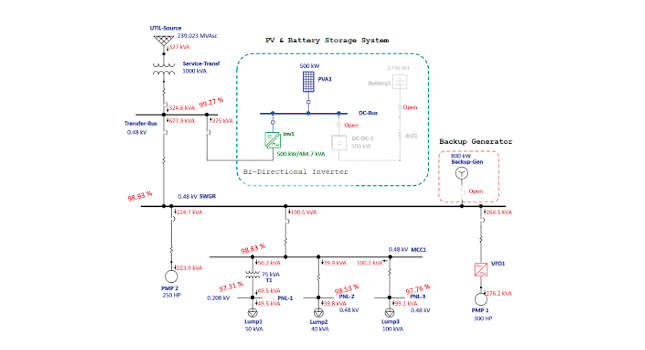As electrical power and lighting systems become more complex, modeling for safe and reliable electrical operations becomes increasingly important

Learning Objectives
- Discover several major electrical power system and lighting software tools.
- Consider integrating software options with a building information modeling package.
- Review an example of using electrical power system software.
As electrical power system in facilities such as generation stations, industry complexes, hospitals, water pumping stations, water treatment plants, processing plants and other similar facilities expand and become more complex — specifically with integrating microgrid systems for system reliability and cost savings — electrical distribution system model development and proper system analyses become increasingly important.
These systems require advanced industrial electrical software tools for modeling and performing different studies, especially with the increasing availability of convertible equipment such as inverters, variable frequency drives and distributed energy resources such as photovoltaic and battery energy storage systems.
From the conceptual design to operating these complex systems, facility personnel must consider as it is a “living” entity that changes significantly over time as loads increase, equipment is replaced or upgraded, systems are enhanced or utility interconnection parameters change.
Electrical design, analysis software tools
There are numerous industrial electrical system analysis software tools currently available for designers and engineers to analyze power systems, such ETAP, SKM PowerTools, EasyPower, PowerWorld, PSS E, PSCAD, CYME, DIgSILENT. These tools are capable of building complex electrical generation, distribution or transmission system models and performing a variety of system studies, such as load flow, motor starting and voltage stability, short circuit, protective device coordination and equipment protection, arc flash, harmonic, reliability, real time automation, control and monitoring.
In addition, there are available online software tools that can be used to perform, for example, equipment sizing calculations for generator sizing to verify the adequacy of existing or new generators under different loading conditions.
Electrical lighting design software such as agi32 and Elumtools by Lighting Analysts, Visual Lighting Software by Acuity Brands and DIALux by Dial Gmbh are a few commonly used suites used to perform lighting photometric calculations, daylighting simulations and lighting-based visual renderings.
Lighting design software, such as Elumtools, allows designers to perform photometric calculations in the building information modeling application because designers are typically already using BIM to develop models and engineering drawings. This integration allows the lighting designer to seamlessly use model parameters input into the BIM model to perform lighting calculations.
In general, several of these electrical and lighting software packages such as ETAP, SKM PowerTools, EasyPower or Elumtools can integrate into BIM workflows. Used in conjunction with data exchange modules, these software options can exchange data with BIM modeling software, such as Autodesk Revit to maintain the overall integrated design approach and consistency.
These bi-directional data exchange packages simplify and reduce cost of the electrical design process in short and long terms by using the data that already exist in the Revit to automatically generate electrical models to perform electrical system study (see Figures 1 and 3) or use it to design and analyze lighting calculations.
Importance, selection of software
Each facility may select or prefer to use any of the previously mentioned software or another software, based on:
- Specific application.
- Alternating current direct current or real-time module availability.
- Cost.
- Prior experience.
- Vendor support and training.
- Software quality programs.
- User friendliness.
It is difficult to properly evaluate the right software and its limitations without making significant labor and financial investments. Regardless of the electrical software used, it is important for a facility to have such a model available and to regularly maintain it. Having a facility model can help to identify electrical system limitations and issues, improve system reliability and personnel safety and helps engineers with variety of system modifications such as microgrid to provide an alternative source for reliable and cost-saving operation.
Learning to use electrical design software
The following example illustrates the need for an electrical software tool to model and perform a feasibility study for integrating a microgrid into the existing facility and evaluate different system configurations. Note that for this study, no Revit integration is used due to the small facility size. Revit integration is typically applicable to much larger and complex system where it can offer more benefits.
This facility is fed from 13.2 kilovolt circuits via a single 1,000 kilovolt-amperes service transformer, an on-site 800 kilowatts backup generator and 500 kilowatts DER (including PV and BESS).
The DER is connected to utility system by a 500-kilowatt bi-directional inverter that can supply (from PV or BESS) or absorb (BESS charging) power. A simplified electrical system when the facility is fed from utility source is shown in Figure 4.
Figure 5: In this example, an electrical distribution system ETAP model when a facility is fed power from both utility and distributed energy resources sources is shown. Courtesy: CDM Smith[/caption]
Codes and standards
The following standards are applicable to performing power system studies such as the load flow, short circuit, protective device coordination, motor starting, harmonic, reliability and arc flash analyses:
- ANSI/IES LP-7-20 Lighting Practice: The Lighting Design and Construction Process.
- ANSI/IES TM-32-19 Technical Memorandum: Lighting Parameters for Building Information Modeling.
- IEEE 519-2014: IEEE Recommended Practice and Requirements for Harmonic Control in Electric Power Systems.
- IEEE 1547-2018: IEEE Standard for Interconnection and Interoperability of Distributed Energy Resources with Associated Electric Power Systems Interfaces.
- IEEE 1584-2018: IEEE Guide for Performing Arc-Flash Hazard Calculations.
- IEEE 2: IEEE Draft Recommended Practice for Conducting Load-Flow Studies of Industrial and Commercial Power Systems.
- IEEE 3: IEEE Draft Recommended Practice for Conducting Short-Circuit Studies of Industrial and Commercial Power Systems.
- IEEE 7: IEEE Recommended Practice for Conducting Motor-Starting Studies and Analysis of Industrial and Commercial Power Systems.
- IEEE 8: IEEE Draft Recommended Practice for Conducting Harmonic-Analysis Studies of Industrial and Commercial Power Systems.
- NFPA 70: National Electrical Code.
Designing new facilities or making system modifications and improvements without having electrical modeling and analyses can lead to costly failures and jeopardize personnel safety. It is highly recommended to invest and build electrical distribution system models — especially for facilities that are more complex and plan to or already have additional uninterruptable sources such as a microgrid system. This is necessary to understand the facility’s capability for safe and reliable operation.




